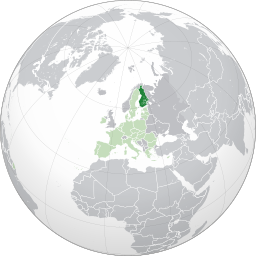[vc_row][vc_column width=”1/2″][vc_column_text]
Finland
The light green area is the rest of the European Union
Finland was the 42nd largest economy in the world by nominal GDP in 2018. GDP per capita is $44,648 USD, which is above the average for high income and OECD countries. Finland is strong in manufacturing, particularly in the wood, metals, engineering, telecommunications, and electronics industries. It also has a strong ICT sector. It is ranked 5th in the World Bank's Human Capital Index and 8th in terms of Economic Complexity (2017). It is a member of the EU and OECD. Services was the largest economic sector in 2018 (59 percent of GDP), followed by manufacturing (15 percent), and agriculture (2 percent). In 2017, the largest export sectors were services (29 percent), agriculture (15.34 percent), machinery (11 percent), metals (9 percent), and chemicals (8 percent). The largest individual exports were ICT services (21 percent), refined petroleum (4.8 percent), paper and paperboard (4.2 percent), and transport (4.1 percent). Its largest export partners were Germany (12.6 percent), Sweden (9.85 percent), USA (7.92 percent), the Netherlands (6.1 percent), and China (5.28 percent). The largest goods imports were crude oil (5.71 percent), cars (4.08 percent), and refined petroleum (3.15 percent). Reforms in the 1860s laid the foundation for Finland's modernisation, including the introduction of its own currency. In 1917 it declared independence from Russia. Post World War Two, the economy was still dominated by agriculture and wood, but from the 1950s, industrialisation increased as Finland rebuilt after the war and had to provide manufactured goods to Russia for reparations. The oil crisis slowed growth in the 1970s with increased trade to Russia compensating. With the collapse of the Soviet Union, trade was hit hard, but from the 1990s the electrical engineering and electronics sectors grew, outstripping wood as the leading export. Finland was turning towards knowledge-based industries becoming the diverse economy it is today. Despite sound macroeconomic fundamentals, the 2008-09 global financial crisis hit hard and was compounded by the collapse of Nokia's mobile phone market share. The economy initially recovered but then contracted between 2012 and 2014 due to several factors including sanctions on Russia because of its conflict with Ukraine and a collapse in the price of paper. Structural reforms such as the 2016 Competitiveness Compact with unions has helped the economy recover since and are the key to future growth.
[/vc_column_text][vc_column_text] Its population in 2018 was 5,542,517 [1]
Its population in 2018 was 5,542,517 [1]
 In 2015, 43.24% of its total energy
In 2015, 43.24% of its total energy
consumption was renewable [2]
 In 2021, its GDP grew by 3.47% [2]
In 2021, its GDP grew by 3.47% [2]
 In 2021 it had a positive Current
In 2021 it had a positive Current
Account Balance of US$bn 2.77 [3]
 Its unemployment rate in 2021 was 7.63% [3]
Its unemployment rate in 2021 was 7.63% [3]
 Its Expenditure on R&D (as a percentage of
Its Expenditure on R&D (as a percentage of
GDP) in 2020 was 2.94% [2]
What free trade areas or economic unions is it a member of?
Member of the European Union (EU) since 01/01/1995
Other members:
Austria, Belgium, Bulgaria, Croatia, Cyprus, Czechia, Denmark, Estonia, France, Germany, Greece, Hungary, Ireland, Italy, Latvia, Lithuania, Luxembourg, Malta, Netherlands, Poland, Portugal, Romania, Slovakia, Slovenia, Spain, Sweden
What trade deals are there between European Union and other countries and economic unions?
EU - Andorra Customs Union (from 01/01/1991)
European Single Market (SM) (from 01/01/1993)
EU - Sri-Lanka Co-operation and Partnership Agreement (from 01/04/1995)
EU - Türkiye Customs Union (from 31/12/1995)
EU - Faroe Islands Agreement (from 01/01/1997)
EU - Palestinian Authority Interim Association Agreement (from 01/07/1997)
EU - Tunisia Association Agreement (from 01/03/1998)
EU - Armenia Partnership and Cooperation Agreement (from 09/09/1999)
EU - Morocco Association Agreement (from 01/03/2000)
EU - Israel Association Agreement (from 01/06/2000)
EU - Mexico Global Agreement (from 01/10/2000)
EU - San Marino Customs Union (from 01/04/2002)
EU - Jordan Association Agreement (from 01/05/2002)
EU - North Macedonia Stabilisation and Association Agreement (from 01/04/2004)
EU - Pakistan Co-operation agreement (from 29/04/2004)
EU - Egypt Association Agreement (from 01/06/2004)
EU - Chile Association Agreement and Additional Protocol (from 01/03/2005)
EU - Algeria Association Agreement (from 01/09/2005)
EU - Lebanon Association Agreement (from 01/04/2006)
EU - Albania Stabilisation and Association Agreement (from 01/04/2009)
EU - Pacific States Interim EPA (from 20/12/2009)
EU - Montenegro Stabilisation and Association Agreement (from 01/05/2010)
EU - Central America Association Agreement (from 01/08/2013)
EU - Serbia Stabilisation and Association Agreement (from 01/09/2013)
EU - Bosnia and Herzegovina Stabilisation and Association Agreement (from 01/06/2015)
EU - South Korea Free Trade Agreement (from 01/07/2015)
EU - Kosovo Stabilisation and Association Agreement (from 01/04/2016)
EU - Georgia Association Agreement (from 01/07/2016)
EU - Moldova Association Agreement (from 01/07/2016)
EU - Canada Comprehensive Economic and Trade Agreement (CETA) (from 21/09/2017)
EU - Eswatini (SADC) Economic Partnership Agreement (from 05/02/2018)
EU - Lesotho (SADC) Economic Partnership Agreement (from 05/02/2018)
EU - Mozambique (SADC) Economic Partnership Agreement (from 05/02/2018)
EU - Namibia (SADC) Economic Partnership Agreement (from 05/02/2018)
EU - South Africa Economic Partnership Agreement (from 05/02/2018)
EU - Botswana (SADC) Economic Partnership Agreement (from 05/02/2018)
EU - Japan Economic Partnership Agreement (from 01/02/2019)
EU - Eastern and Southern Africa States free trade agreement (from 07/02/2019)
UK - EU Trade Deal (from 01/01/2021)
[/vc_column_text][vc_column_text]What trade deals are there with other countries and economic unions?
None
[/vc_column_text][/vc_column][vc_column width=”1/2″][vc_column_text]World Bank Group President Brings Hopeful Message to Middle East
Janamitra Devan: The Innovation Imperative
Trade with the United Kingdom
Source: UK Office for National Statistics, October 2022.
Contains public sector information licensed under the Open Government Licence v3.0.
Loading, Please Wait!
This may take a second or two.



















































































